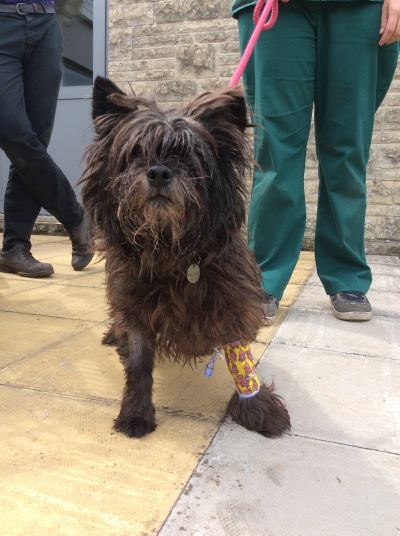
Posted By:
When owners find an unexpected lump on their pets this can, naturally, be a cause for alarm and something that most want to get checked out straight away. Of course, it is normal to worry that a lump is something sinister but it is important to remember that many lumps and bumps can be successfully treated or managed, especially if detected early.
On such example is Mac, a now 12 ½ year old Cairn Terrier who was first brought in over 2 years ago when he had a lump develop on his right front leg. At that point the lump was tested, with a sample of cells analysed at the lab. The results suggested that the mass was of a type that would not spread but would continue to grow and could potentially cause problems if it was to be traumatised.
Removing lumps from the body is quite a common undertaking in veterinary surgery, and can often be fairly straightforward. As long as there is plenty of spare skin in the surrounding area we can usually close the deficit that remains after the unwanted tissue is removed. However, this is not the case when we are dealing with lumps on the limbs – spare skin is at a minimum – so planning surgical removal of Mac’s lump was tricky. Mac was admitted for surgery and the mass was removed but, due to its size and location, we had to leave behind some of the skin that had been in contact with the mass, so that we could close the wound.
Mac healed well and was a very happy dog for two years until the mass started to re-grow. Mac was brought back to see us and tests confirmed that the mass was of the same nature as before. Tiny numbers of cells from the mass must have been present in the skin surrounding it, left behind at the previous surgery due to the limited skin available. So now we had to discuss our options.
Mac was a little dog still in very good health. The biggest concern, both for his owners and us, was that the mass was becoming uncomfortable for him and was, at times, becoming traumatised when he as playing or even just lying down. Trauma to such a mass could lead to an extensive wound that could be painful and incredibly difficult to heal.
We discussed multiple options for how we could help Mac, from radiotherapy to further surgery. At the time of the discussions we also became aware of a new surgical device that was launched. The device was a simple skin expansion implant – something that is often used in human surgery and was now developed for vets. The implant(s) are designed to be surgically inserted under the skin next to a mass and then left in place. Over the following 2 weeks they slowly expand, therefore stretching the skin and thus creating additional tissue to help with wound closure. After 2 week the implants can be removed and the lump removed, with the new stretchy skin ready to be pulled into place.
After careful consideration Mac’s owners elected for the implant. As such, photos of Mac’s leg were taken and sent to specialists who helped us plan the overall surgical approach. Once the planning had taken place Mac’s surgery was scheduled.
Mac was admitted for phase one of his procedure and later that day he returned home after his anaesthetic with a bandage on his leg and 3 of the skin expansion devices under his skin. His owners at that point monitored him incredibly closely for 2 weeks until he returned for phase 2 of his surgery.
The 2nd stage of his surgery was a lot more technically difficult but helped greatly by the pre-planning diagrams that had been drawn. Mac was anaesthetised, the devices removed and the lump was cut away. The surrounding skin was then cut to create flaps that could fill in the deficit created and then everything was closed. We knew that, despite the expansion, it was likely we would still be left with a skin deficit resulting in an open wound and this was indeed the case. As such a special dressing was placed after the surgery and Mac was then woken up so, once again, he could look forward to going home.
It can’t be under estimated how much effort Mac’s owners put into his care as, over the next 2 months, he visited us regularly to have his dressings changed and then, latterly, his owners were trained to do the dressings at home. Week by week the deficit got smaller and Mac remained happy throughout. However, he was quite clearly at his happiest when we could, finally, remove his dressings and he had is leg back to himself.
Mac’s condition could still potentially return, as cells of the mass most likely remain in the deeper tissue. There are no visible signs of the mass at present and, if we can manage the growth for a period of years, then Mac’s surgery will prove to have been very successful. And, once again, it was only achievable because of the dedication and amazing care that his owners were able to give him throughout his treatment.
Whilst on my visits I have been having several discussions...
As our feline friends get older there are a few conditions...
Another winter discussion group season is now behind...
©2024 Shepton Veterinary Group Ltd., All rights reserved.
Privacy Policy • Terms & Conditions • Cookie Policy